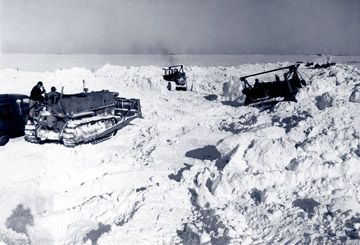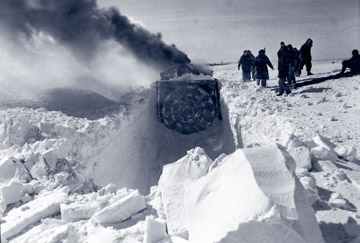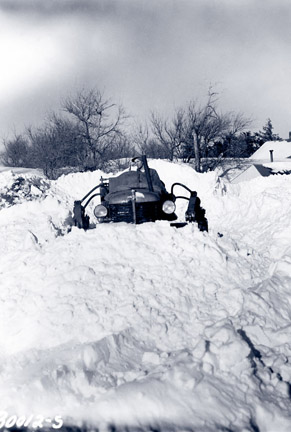In November 1948, a severe blizzard passed over parts of Nebraska, Wyoming, and Colorado, dumping several feet of snow, blocking transportation lines, and isolating towns and ranches throughout the region. Before the people in the area could fully recover, another storm hit an even wider area on 2 January 1949. The National Guard responded with snow plows and M–29 cargo carriers known as Weasels, essentially enclosed jeeps with tank treads, to rescue people and provide emergency supplies. State highway departments struggled to open roads. On 11 January the Air Force launched the short-lived Operation Hayride (later revived as Haylift) to airdrop supplies to snowed-in families and bales of hay to starving livestock.
Both the highway departments and the states’ Guard units were soon overwhelmed when on 25 January 1949 a third blizzard descended on Nebraska, Wyoming, and the Dakotas, covering the area with three feet of snow and even higher drifts. Days prior, Maj. Gen. Lewis Pick, commander of the Corps’ Missouri River Division, had gathered his staff to plan a possible response to the disaster. After Maj. Gen. John Lucas of Fifth Army toured the area, he requested that the Corps be directed to lead an emergency response operation. Once President Truman declared the region a major disaster area on 29 January, Pick and the rest of the division officially responded with Operation Snowbound.
 |
|
 |
| Bulldozers clearing away mounds of snow. |
|
Using machinery to clear a path through snow several feet deep. |
| |
|
|
|
Pick established the operation’s headquarters at Omaha District, where he coordinated the activities of personnel in the Omaha, Garrison, and Denver districts and in existing and new area offices in Nebraska, Wyoming, and the Dakotas. Corps personnel from nearby dam projects, Fifth Army officers experienced with heavy equipment, and twenty-five officers from the Engineer School at Fort Belvoir arrived to assist. The Navy created a radio network to keep communications open. Soon the Air Force’s Operation Haylift and all state, local, and Red Cross rescue and relief efforts fell under the Snowbound umbrella.
The responders used aircraft to perform reconnaissance and drop supplies. Army Weasels ran atop the snow to bring supplies to stormbound residents. Following behind were mobile strike forces made up of bulldozers, snowplows, fuel trucks, wreckers, tractors, and cargo vehicles. At its peak, 6,237 people participated in the effort, including 807 Army officers, 959 Corps employees, and over 4,000 contractors. They used 1,654 pieces of snow-clearing equipment in a disaster area covering 193,000 square miles with an estimated population of 1.2 million.
Those in the field faced hazardous conditions—high winds that blew granular snow and splinters of ice, extreme cold that caused frostbite, and drifting snow that often blocked roads behind them. Several suffered from snow blindness, and one soldier and six civilians died in accidents. Lt. Richard Hartline and Corporals John Donnelly and Melvin Shoemaker of the Corps of Engineers received the Army Commendation Ribbon for their efforts in Snowbound, the first disaster response mission for which the ribbon was awarded. On 15 March 1949, Operation Snowbound came to a successful end. The personnel involved had opened over 115,000 miles of roads, freed over 240,000 trapped people, and fed over four million head of livestock.
|
|
 |
| |
|
The Army and National Guard used snowplows, bulldozers, Weasels, and other heavy equipment during Operation Snowbound. |
| |
|
|
Images provided by Omaha Engineer District
For more on the Corps of Engineers' emergency operations mission, see the Office of History publications Situation Desperate (Origins to 1950) and Destruction Imminent (1950 to 1979).
* * *
January 2010. No. 122.